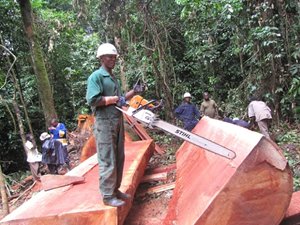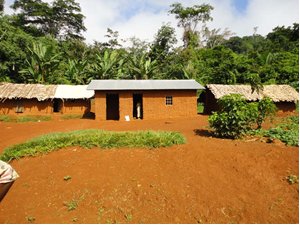Amani Ngoma posted on March 17, 2015 06:04

The new DRC forestry law proposes several innovations to improve the management of natural forests and the impacts of forest exploitation on the livelihoods of forest dwelling communities. One such innovation is found in article 22 of this law which allows the allocation of forest concessions to local communities on the forestlands they claim by virtue of traditional rights. According to the government interpretation of the law, these forest concessions must be used primarily for small-scale timber exploitation following the Cameroonian model[1]. This concept being new in the DRC, it has been recommended to set up pilot project for testing the model before it is used at a larger scale across the country.
The Banana Community-Based Natural Resources Management
Through the CARPE program, community-based natural resources management (CBNRM) projects were started at three sites in the Ituri Forest. At each site a five member NR management committee was formed and trained in basic project management skills. These committees represent local populations in all decision-making process on the management of natural resources, particularly land allocation to outsiders for timber exploitation and agriculture.
One of the three CBNRM projects is located in the Banana community at the eastern limits of the Okapi Faunal Reserve along the RN4 road in the territory of Mambasa. The community is poverty-stricken with average household income below US$150 per year, where only 2% of households have tin-roofed houses. The community is composed of 962 households with average family size of 5.7 people[2]. The indigenous Mbuti pygmies account for approximately 27% of the total households.
Community timber exploitation initiative
In 2008 WCS started a process of acquiring a forest concession for the Banana community and initiated a community timber exploitation project with financial support from the IUCN NL Ecosystem Grant Program. The main objectives of the projects were to 1) generate revenue for community development projects and 2) train members of local communities in project management and the assessment natural resources.
The timber exploitation initiative started by the training of community members in forestry and botanical inventories during the selection the concession site. Then a management team, composed three people, was formed to run the timber exploitation initiative under the oversight of the CBNRM management committee. This team comprised a manager, a secretary, and a treasurer. Principles for revenue sharing were written with the participation of all stakeholders under the guidance of WCS, and revenue from timber sale were to be primarily utilized to run timber exploitation and fund community initiatives such improving education and health infrastructures. A small portion could serve to pay dues to the traditional authority.

Timber harvesting team cutting and sawing an African mahogany tree into planks in the forest
The next step was to equip the community with two chainsaws and associated equipment and materials for timber exploitation. A chainsaw expert was hired to provide practical training to four local youths in the use of chainsaw while kicking off timber production for the community project. However the management of the project posed serious problems soon after timber exploitation was underway. The problems were due to power struggle between the CBNRM committee and the timber exploitation management team. The situation was made worst by the attempt of traditional authority to dominate the decision-making process for the use of timber revenue. These difficulties brought the project activities to a complete stop towards the end of its first year.
Negotiations with all stakeholder resulted in the change at the head of the natural resources committee of the CBNRM. The previous president, who was very old and less active, was replaced by a young and more educated candidate who quickly brought positive change to the management of the community timber exploitation initiative. All the sawn timber that was in the forest was transported to the village and sold. At the end of the first year,13 cubic meters of planks were produced and sold for US$ 2,065. Part of the profit was used to buy mattresses for the local clinic. In addition, 200 pieces of “chevrons”? were produced and used for a local initiative to improve housing conditions. “Chevrons” were sold at a reduced price to construct tin-roofed houses for individual community members who had the means to buy metal sheets. In June 2010, 16 houses were constructed or under construction.


These tin-roofed houses represent the highest quality and most durable housing type in the area. The 16 houses account for over 50% of all houses of this type in the community.
Accomplishments from the initiative have greatly contributed to raise awareness on the value of the forest, particularly timber resources. Costs for acquiring forest concessions for artisanal logging have substantially increased, reducing the number of artisanal logging in the area, and eventually contributing to reduce the rate of forest degradation and loss of biodiversity.
[1] Cuny, P., P. Abe’ele, GM Nguenang, NA Eboule Singa, A Eyen Essomba & R. Djeukam. 2003. Etat des lieux de la foresterie communautaire au Cameroun. Ministère de l’Environnement et des Forêts, Cameroun.
[2] Données de recensement WCS- DRC Forestry, Mai 2010